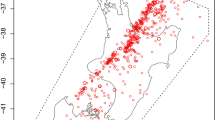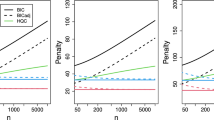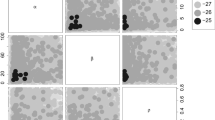Abstract
This paper proposes a new model—the Markov-modulated Hawkes process with stepwise decay (MMHPSD)—to investigate the variation in seismicity rate during a series of earthquake sequences including multiple main shocks. The MMHPSD is a self-exciting process which switches among different states, in each of which the process has distinguishable background seismicity and decay rates. Parameter estimation is developed via the expectation maximization algorithm. The model is applied to data from the Landers–Hector Mine earthquake sequence, demonstrating that it is useful for modelling changes in the temporal patterns of seismicity. The states in the model can capture the behavior of main shocks, large aftershocks, secondary aftershocks, and a period of quiescence with different background rates and decay rates.
Similar content being viewed by others
References
Akaike H. (1974) A new look at the statistical model identification. IEEE Transactions on Automatic Control, 19(6): 716–723
Akaike, H. (1978). A Bayesian analysis of the minimum AIC procedure. Annals of the Institute of Statistical Mathematics, 30(1), 9–14; also included in E. Parzen et al. (Eds.) (1998), Selected papers of Hirotugu Akaike (pp. 275–280). Berlin: Springer.
Bebbington M.S. (2007) Identifying volcanic regimes using hidden Markov models. Geophysical Journal International, 171: 921–942
Bebbington M.S. (2008) Estimating rate- and state-fraction parameters using a two-node stochastic model for aftershocks. Tectonophysics, 457: 71–85
Bebbington M.S., Harte D.S. (2001) On the statistics of the linked stress release model. Journal of Applied Probability, 38A: 176–187
Bebbington M.S., Harte D.S., Jaumé S.C. (2010) Repeated intermittent earthquake cycles in the San Francisco Bay Region. Pure and Applied Geophysics, 167: 801–818
Borovkov K., Bebbington M.S. (2003) A stochastic two-node stress transfer model reproducing Omori’s law. Pure and Applied Geophysics, 160: 1429–1445
Bowsher C.G. (2007) Modelling security market events in continuous time: intensity based, multivariate point process models. Journal of Econometrics, 141: 876–912
Brémaud P., Massoulié L. (1996) Stability of nonlinear Hawkes processes. Annals of Probability, 24: 1563–1588
Bufe C.G., Varnes D.J. (1993) Predictive modeling of the seismic cycle of the greater San Francisco Bay region. Journal of Geophysical Research, 98: 9871–9883
Daley D.J., Vere-Jones D. (2003) Introduction to the theory of point processes (2nd ed). Springer, New York
Fedotov S.A. (1968) The seismic cycle, quantitative seismic zoning, and long-term seismic forecasting. In: Medvedev S.V. (eds) Seismic zoning in the USSR. Izdatel’stvo Nauka, Moscow, pp 133–166
Fischer W., Meier-Hellstern K.S. (1993) The Markov-modulated Poisson process (MMPP) cookbook. Performance Evaluation, 18(2): 149–171
Fletcher R., Powell M.J.D. (1963) A rapidly convergent method for minimization. The Computer Journal, 6: 163–168
Harte, D. S. (2005). Package “HiddenMarkov”: discrete time hidden Markov models. R statistical program routines. Wellington: Statistics Research Associates. http://cran.at.r-project.org/web/packages/HiddenMarkov.
Hawkes A.G. (1971) Spectra of some self-exciting and mutually exciting point processes. Biometrika, 58: 83–90
Hawkes A.G., Adamopoulos L. (1973) Cluster models for earthquakes-regional comparisons. Bulletin of the International Statistical Institute, 45: 454–461
Heffes H., Lucantoni D. (1986) A Markov modulated characterization of packetized voice and data traffic related statistical performance. IEEE Journal on Selected Areas in Communications, 4: 856–868
Helmstetter, A., Sornette, D. (2002). Subcritical and supercritical regimes in epidemic models of earthquake aftershocks. Journal of Geophysical Research, 107. doi:10.1029/2001JB001580
Hill, D. P., Reasenberg, P. A., Michael, A., Arabaz, W., Beroza, G. C., Brune, J. N., Brumbaugh, D., Davis, S., DePolo, D., Ellsworth, W. L., Gomberg, J., Harmsen, S., House, L., Jackson, S. M., Johnston, M., Jones, L., Keller, R., Malone, S., Nava, S., Pechmann, J. C., Sanford, A., Simpson, R. W., Smith, R. S., Stark, M., Stickney, M., Walter, S., Zollweg, J. (1993). Seismicity in the western United States remotely triggered by the M7.4 Landers, California, earthquake of June 28, 1992. Science, 260, 1617–1623.
Hill D.P., Johnston M.J.S., Langbein J.O., Bilham R. (1995) Response of Long Valley caldera to the M w = 7.3 Landers, California, earthquake. Journal of Geophysical Research, 100: 12985–13005
Hughes J.P., Guttorp P. (1994) A class of stochastic models for relating synoptic atmospheric patterns to regional hydrologic phenomena. Water Resources Research, 30: 1535–1546
Jaumé, S. C., Bebbington, M. S. (2004). Accelerating seismic release from a self-correcting stochastic model. Journal of Geophysical Research, 109, B12301. doi:10.1029/2003JB002867
MacDonald I., Zucchini W. (1997) Hidden-Markov and other models for discrete-valued time series. Chapman and Hall, New York
Marsan D. (2003) Triggering of seismicity at short timescales following Californian earthquakes. Journal of Geophysical Research, 108: 2266. doi:10.1029/2002JB001946
Marsan D., Nalbant S.S. (2005) Methods for measuring seismicity rate changes: a review and a study of how the M w 7.3 Landers earthquake affected the aftershock sequence of the M w 6.1 Joshua Tree earthquake. Pure and Applied Geophysics, 162: 1151–1185
Mogi K. (1968) Source locations of elastic shocks in the fracturing process in rocks (1). Bulletin of Earthquake Research Institute, 46: 1103–1125
Ogata Y. (1988) Statistical models for earthquake occurrences and residual analysis for point processes. Journal of the American Statistical Association, 83(401): 9–27
Ogata Y. (1998) Space-time point-process models for earthquake occurrences. Annals of the Institute of Statistical Mathematics, 50: 379–402
Ogata, Y., Jones, L. M., Toda, S. (2003). When and where the aftershock activity was depressed: contrasting decay patterns of the proximate large earthquakes in southern California. Journal of Geophysical Research, 108(B6), 2318. doi:10.1029/2002JB002009 (ESE1-12).
Pievatolo A., Rotondi R. (2008) Statistical identification of seismic phases. Geophysical Journal International, 173: 942–957
Rabiner L.R. (1989) A tutorial on hidden Markov models and selected applications in speech recognition. Proceedings of the IEEE, 77: 257–286
Roberts W.J.J., Ephraim Y., Dieguez E. (2006) On Rydén’s EM algorithm for estimating MMPPs. IEEE Signal Processing Letters, 13(6): 373–376
Rydén T. (1994) Parameter estimation for Markov modulated Poisson processes. Communications in Statistics–Stochastic Models, 10(4): 795–829
Rydén T. (1996) An EM algorithm for estimation in Markov-modulated Poisson processes. Computational Statistics & Data Analysis, 21: 431–447
Schwarz G. (1978) Estimating the dimension of a model. Annals of Statistics, 6: 461–464
Shibata R. (1980) Asymptotically efficient selection of the order of the model for estimating parameters of a linear process. The Annals of Statistics, 8: 147–164
Shibata R. (1981) An optimal selection of regression variables. Biometrika, 68(1): 45–54
Utsu T., Ogata Y., Matsu’ura R.S. (1995) The centenary of the Omori formula for a decay law of aftershock activity. Journal of Physics of the Earth, 43: 1–33
Van Loan C.F. (1978) Computing integrals involving the matrix exponential. IEEE Transactions on Automatic Control, AC- 23(3): 395–404
Vere-Jones D., Robinson R., Yang W. (2001) Remarks on the accelerated moment release model: problems of model formulation, simulation and estimation. Geophysical Journal International, 144: 517–531
Wang, T. (2010). Statistical models for earthquakes incorporating ancillary data. PhD thesis, New Zealand: Massey University.
Zhuang J. (2000) Statistical modeling of seismicity patterns before and after the 1990 Oct 5 Cape Palliser earthquake, New Zealand. New Zealand Journal of Geology and Geophysics, 43: 447–460
Zucchini W., Guttorp P. (1991) A hidden Markov model for space-time precipitation. Water Resources Research, 27(8): 1917–1923
Author information
Authors and Affiliations
Corresponding author
About this article
Cite this article
Wang, T., Bebbington, M. & Harte, D. Markov-modulated Hawkes process with stepwise decay. Ann Inst Stat Math 64, 521–544 (2012). https://doi.org/10.1007/s10463-010-0320-7
Received:
Revised:
Published:
Issue Date:
DOI: https://doi.org/10.1007/s10463-010-0320-7




